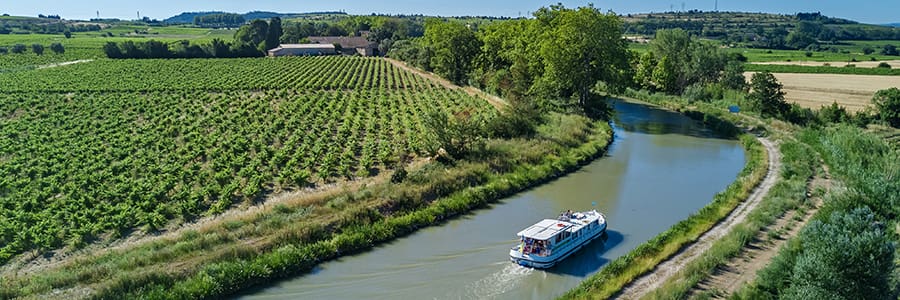
About The Canals of France
C’est magnifique!
For a “deep dive” into French gastronomy, scenery, culture, and history, nothing beats a cruise along the French canals, part of a network of waterways that includes 100 canals and rivers. Each offers an intimate look at a unique facet of “la vie en rose:” from Paris and Normandy, Burgundy and Toulouse, to the sunny South of France, epicurean Strasbourg, and historic Reims, Calais, and Dunkirk.
Boasting a wealth of cultural treasures — in art and architecture, food and wine, fashion and fine living — every corner of France has its own unique personality. So, come indulge your passion for chocolates, truffles, port wine, lavender, medieval history, spectacular scenery and wildlife — whatever French masterpiece suits your fancy!
Traveling on your own vessel or on a hotel barge or charter is an ideal way to experience everyday life in the places you visit. Canal boats can travel almost anywhere, from secluded anchorages amidst peaceful surroundings to the center of many major cities.
Canals of France Stats
Length: Almost 5,000 miles of canals throughout France
Depth: Various
Source: Many canals source from the Pyrenees and Alps regions of Europe
Mouth: The Mediterranean, Bay of Biscay and English Channel
Locks: Many
Countries: France
Learn More About the Navigable Canals of France
France, a country renowned for its rich cultural heritage, picturesque landscapes, and culinary excellence, is also home to an extensive network of navigable canals that have played a pivotal role in shaping its history, economy, and culture. These canals, often overlooked by tourists in favor of more famous attractions, offer a unique perspective on France’s past and present. In this exploration, we will delve into the fascinating world of France’s navigable canals, tracing their evolution from early engineering marvels to modern transportation hubs and leisure destinations.
A Historical Tapestry
The history of navigable canals in France can be traced back to antiquity. The Romans, with their engineering prowess, were among the first to recognize the potential of waterways for transportation and irrigation. They built canals such as the Canal de la Robine in the first century AD, which connected the Mediterranean Sea to the Atlantic Ocean, demonstrating early feats of engineering. However, it was during the Middle Ages that canal construction in France truly gained momentum. Monasteries and feudal lords constructed rudimentary canals for irrigation and transportation, allowing goods to be transported more efficiently. These canals served as precursors to the elaborate network that would emerge in the following centuries.
The Canal Revolution
The 17th century marked a turning point in the development of France’s navigable canals. The visionary engineer, Jean-Baptiste Colbert, under the reign of Louis XIV, initiated a canal-building boom that connected major rivers and regions of France. The most iconic of these projects was the Canal du Midi, which linked the Atlantic Ocean to the Mediterranean Sea, providing a vital trade route and showcasing impressive feats of engineering, including the famous Malpas Tunnel.
Industrialization and Economic Growth
The 19th century brought further expansion of France’s canal network, coinciding with the industrial revolution. Canals played a crucial role in transporting coal, raw materials, and finished products, contributing significantly to the country’s economic growth. The Canal de Saint-Quentin, connecting the North Sea to the Seine River, was a prime example of this era’s canal infrastructure development.
The Decline and Revival
By the mid-20th century, with the advent of railways and roadways, many canals fell into disuse. They were deemed outdated and were often neglected. However, a renewed interest in preserving this unique cultural and historical heritage emerged in the late 20th century. Government initiatives, private investments, and the recognition of canals as UNESCO World Heritage Sites breathed new life into these waterways.
Modern Navigable Canals
Today, France’s navigable canals serve a variety of purposes. While some remain vital for commercial shipping, others have transformed into leisure destinations. The Canal du Nivernais, for instance, winds through the picturesque Burgundy region, attracting tourists with its serene beauty and offering opportunities for boating, cycling, and wine-tasting along the way.
Engineering Marvels
The construction of these canals was no small feat. Engineers had to overcome challenging terrain, construct impressive aqueducts and tunnels, and manage water resources efficiently. The Riquet family, responsible for the Canal du Midi, epitomizes the ingenuity and determination that went into creating these waterways.
Cultural Significance
France’s navigable canals are not just engineering marvels; they are also repositories of culture and history. The villages and towns along these waterways have preserved their traditional architecture and way of life, offering a glimpse into rural France. The canal-side markets, festivals, and local cuisine provide visitors with an authentic experience.
Sustainable Transportation
In recent years, there has been a renewed emphasis on the environmental benefits of canal transportation. It is an energy-efficient and eco-friendly mode of transport, reducing greenhouse gas emissions and road congestion. This focus on sustainability aligns with modern environmental goals and underscores the continued relevance of these canals.
Challenges and Future Prospects
While France’s navigable canals have enjoyed a resurgence, they are not without challenges. Maintenance and restoration efforts require significant funding, and climate change poses threats to water levels and infrastructure. However, innovative solutions, such as solar-powered barges and sustainable tourism practices, are being explored to ensure their long-term viability.
